|


Navigation Center™ Systems
ANDMap® Network Numbering
05/07/1997
by Bryan S. Coffman
The numbering system for symbols on an ANDMap
document provides information concerning the symbol and its place within
the mapping system, and allows for each symbol to have a unique identification
tag.
Because every activity on an ANDMap document supports a potential connection
to every other activity on that map (and on other maps as well), a strictly
hierarchical numbering system sets too many constraints on interpretation
and manipulation of the map. Just because an Event symbol is a precedent
to a subsequent Benchmark, it does not follow that the number of the Event
should be tied to the number of the Benchmark. An Event may precede any
number of other activities, or it may be the subsequent to several activities
as well.
Numbering System Overview: Activity Identifiers
Each symbol on the map has its own Activity Identifier that consists of
three components:
- a map identifier,
- a symbol identifier, and possibly
- a symbol version identifier.
Each identifier is separated by an underline. A typical, complete Activity
Identifier might look like this:
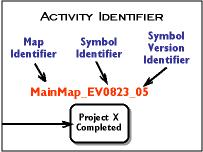 A map identifier is usually a short version of the map's
name. An ANDMap document named "ABC Corporation Strategic Plan"
might employ "ABCCorp" for its map identifier. Within a network
of NavCenters, all of the map identifiers should be unique. Within a single
map, all of the activity identifiers should be unique, and each time an
activity changes an important characteristic, it should generate a unique
revision number. A map identifier is usually a short version of the map's
name. An ANDMap document named "ABC Corporation Strategic Plan"
might employ "ABCCorp" for its map identifier. Within a network
of NavCenters, all of the map identifiers should be unique. Within a single
map, all of the activity identifiers should be unique, and each time an
activity changes an important characteristic, it should generate a unique
revision number.
Sequential Numbering Conventions for ANDMap Symbol
Identifiers
ANDMap symbol identifiers have two parts. The first two characters are
letters indicating the type of symbol. Landmarks use the letter "LM",
Benchmarks the letter "BM" and so on. Following the initial
letter is a sequential number. Usually the first of any type of symbol
on the map receives the number 0100. Following this scheme, the first
Event would have the identifier EV0100. The first Benchmark's identifier
would read BM0100.
While constructing a map, symbols are usually numbered sequentially by
type, with the number increasing over time (as the map is read from left
to right). For example, if a map runs from April through June and contains
three Events in sequence and two Benchmarks, the Events might be numbered
EV0100, EV0110 and EV0120. The Benchmarks could be numbered BM0100 and
BM0150.

Leave some breathing room between consecutive numbers of activities on
a map, especially during initial construction. Simply increment the symbol
number by tens: EV0100, EV0110, EV0120, as shown in the diagram. If, during
a subsequent revision, a new Event is placed between EV0100 and EV0110,
it could receive a number such as EV0105 and the numbering system would
remain intact. There's no reason to feel enslaved to this convention,
but it allows for a quick glance at a list of activities on an Action
Plan to reveal which ones precede the others in time.
The following table lists the symbol identifiers for each symbol on an
ANDMap document.
|
Symbol
|
Name |
Numbering
Scheme |
|

|
Landmark |
LM0100 |
|

|
Benchmark |
BM0100 |
|

|
Cusp |
CS0100 |
|

|
Event |
EV0100 |
|

|
Task |
TK0100 |
|

|
Objective |
OB0100 |
An Example
Suppose a corporation has three ANDMap documents: a corporate map, and
two subordinate maps. One of the subordinate maps is a large scale enlargement
of a portion of the corporate map representing fiscal year 1997; the other
subordinate map tracks the plans of a subsidiary organization.
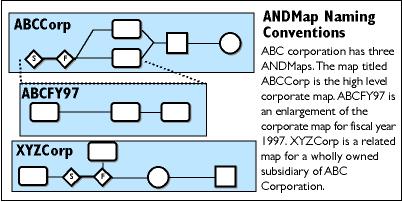
The corporate ANDMap document is named ABCCorp. The first subordinate
map is named ABCFY97. The second subordinate map is named XYZCorp. An
Event on the corporate map is named ABCCorp_EV0100. On activity specification
sheets, the Event is labeled with its complete identifier: ABCCorp_EV0100.
On its home map, the Event is labeled simply as EV0100 (the map name is
a given).
Often an activity from one map shows up on a number of maps besides its
home map. When this happens, the symbol is labeled with its full activity
identifier. If activity EV0100 from the ABCCorp map is shown on the ABCFY97
map, it would be labeled ABCCorp_EV0100 on the ABCFY97 map. Readers now
know that the Event belongs to the home map ABCCorp.
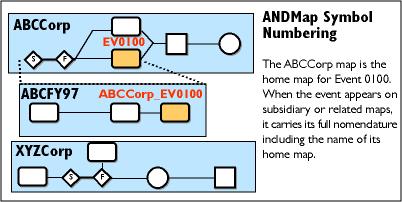
Sometimes an activity undergoes extensive rewording or a change in date.
If the rewording changes the whole intent of activity, simply discard
the old one and replace it with a new one. Give the new symbol a different
symbol identifier to keep it separate from the discarded activity, which
will still reside in the database as part of the history of the map. If
the rewording does not materially change the intent of the activity, or
if the activity changes its date, then add a revision identifier. This
tells users that the activity in question possesses a history of key changes.
Revision identifiers begin with the number "01" and increase
by ones: 01, 02, 03, 04, with each revision. If the title of EV0100 reads:
"Lotus Notes server software installation complete", and it
is subsequently changed to "Lotus Dominos server software installation
complete", the Mapkeeper has the option of deleting the old Event
and replacing it, or adding a revision identifier. The latter choice would
produce the new identifier: EV0100_01. In the knowledge base for the ANDMap
system, both EV0100 and EV0100_01 would retain unique identities but clearly
reveal their relationship to one another. If EV0100 resided on ABCCorp
as its home map, then its complete identifier would look like this: ABCCorp_EV0100_01.
Notes on Events and Tasks in Subordinate or Related
Maps
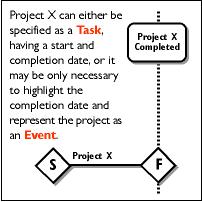 Events and tasks are interchangeable under certain circumstances.
Most high level maps represent certain long duration activities as Tasks,
with a symbol representing the beginning of the Task and a symbol representing
the completion of the Task. But if the start date of the activity is not
crucial to an understanding of the map, and if intermediate milestones
on the Task line belong more properly on a Project
Status Map or Action Plan, then the activity can be represented by
a single Event symbol occupying the space and time of the former Task's
completion date. The title of the Event should be phrased in the past
tense: "Project X completed." Events and tasks are interchangeable under certain circumstances.
Most high level maps represent certain long duration activities as Tasks,
with a symbol representing the beginning of the Task and a symbol representing
the completion of the Task. But if the start date of the activity is not
crucial to an understanding of the map, and if intermediate milestones
on the Task line belong more properly on a Project
Status Map or Action Plan, then the activity can be represented by
a single Event symbol occupying the space and time of the former Task's
completion date. The title of the Event should be phrased in the past
tense: "Project X completed."
Sometimes an Event on a parent map expands into a Task or series of activities
on a subordinate map. It's also possible for a Task on a parent map to
fragment on a subordinate map into a cluster of other activities and symbols
from Landmarks to Milestones. In an extreme case, the Task becomes its
own map (as illustrated in the diagram below). The Task name becomes the
name of the new subordinate map.
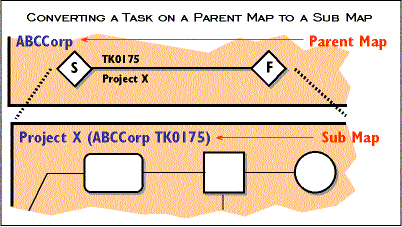
 
copyright © 1997, MG Taylor Corporation.
All rights reserved
copyrights,
terms and conditions
19970507150350.web.bsc
|

